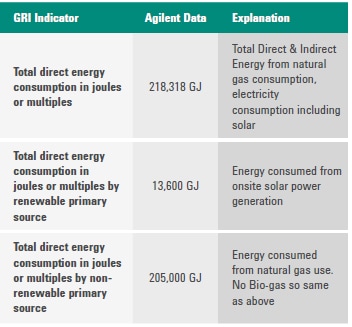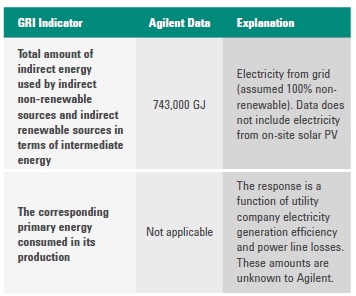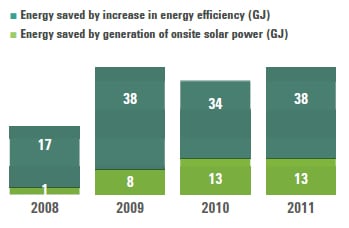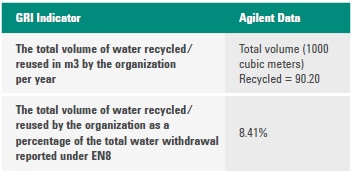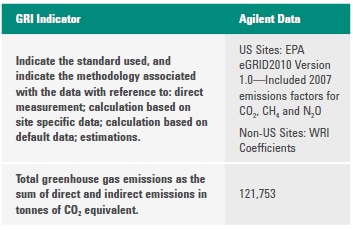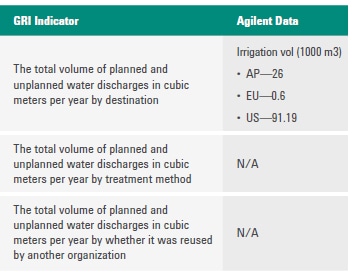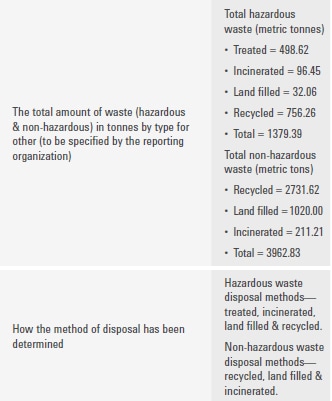Corporate Citizenship Report 2011
|
|
Environmental IndicatorsDMA EN Disclosure on Management Approach EN Agilent is committed to conducting its business in an ethical, socially responsible and environmentally sustainable manner by reporting performance and ensuring that production and operations meet or exceed relevant environmental legislation and regulations. We operate under a company-wide environmental, health and safety management system (EHSMS) that applies to our design, development, manufacturing, distribution and sales and service operations worldwide. Agilent has demonstrated its effectiveness in managing environmental impact by maintaining an ISO 14001 registration of our Environmental Health and Safety Management System (EHSMS). EHSMS is a tool to drive continual improvement in environmental performance and pursuit of sustainability. We expect our suppliers to adhere to the same standard of environmental and social responsibility that we maintain, and our Supplier Environmental and Social Responsibility Code of Conduct requires suppliers to adopt sound environmental, health and safety management practices. Agilent Supplier Code of Conduct Agilent is committed to designing, manufacturing and distributing environmentally responsible products. Environmental aspects are considered in the design, manufacture, distribution, use, obsolescence, disposal, recovery and reuse of Agilent products. Our aim is to minimize environmental impact of our products and operations by conforming to applicable regulations. Agilent has developed an Environmental Compliance Framework to sustain and facilitate compliant product design, development, production, refurbishment and support. When a customer no longer requires an Agilent product, we have implemented several options for reuse, remanufacture or take back based on the product type and customer location to ensure the product is properly managed. Additional information on our environmental and social performance may be found at Agilent's Commitment to Environment and Social Responsibility. Agilent recognizes ISO 26000 as a reference document that provides guidance on social responsibility. Agilent aligns with ISO 26000 standards as part of our social responsibility practices. As such, Agilent's environmental policies, programs and procedures align with ISO Core subjects: Environment 6.4 EN3 Direct energy consumption by primary energy source (The data provided for energy and water has been attested by TruCost)
Notes: 1For FY 11 data - EPA eGRID2010 Version 1.0 included 2007 emissions factors for CO2, CH4 and N20 used to calculate CO2 equivalent emissions from electricity consumption for US facilities. International Electricity Emissions Factor by Country, 1999-2002" were utilized for all Non-U.S. facilities. 2011 Defra factors were used to calculate emissions from stationary fuel consumption. EN4 Indirect energy consumption by primary source
EN5 Energy saved due to conservation and efficiency improvements
EN6 Initiatives to provide energy-efficient or renewable energy based products and services, and reductions in energy requirements as a result of these initiatives During the past several years, Agilent has moved toward product energy efficiency in several product lines. Most of the energy savings are due to two key factors:
Agilent's concentration on portable instruments places a focus on energy efficiency:
EN7 Initiatives to reduce indirect energy consumption and reductions achieved Agilent has a broad spectrum of initiatives ranging from capital spending for energy conservation projects and solar power to operational practices and employee action. For example, prior to delivery to employees, our IT service provider configures PCs and laptops with fully enabled, energy-saving settings. Operationally, we conserve energy by closely managing office heating/cooling and lighting standards and sharing best practices among sites. We also have a corporate energy conservation manager on staff and dedicated staff from our facilities maintenance company, whose primary role is to support the site facilities staff in identifying, implementing, and validating energy-saving opportunities. We completed several energy-conservation infrastructure projects as well as operational improvements in 2011. Our net energy conservation for FY11 was 3.9% (using FY10 total energy spend as a baseline). EN8 Total water withdrawal by source
EN9 Water sources significantly affected by withdrawal of water Agilent's operations do not affect any water sources by the withdrawal of water. EN10 Percentage and total volume of water recycled and reused
EN16 Total direct and indirect greenhouse gas emissions by weight
Total direct and indirect Greenhouse Gas (GHG) emissions by weight1 (Metric Kilotonnes CO2)
Notes:
EN17 Other relevant indirect greenhouse gas emissions by weight
EN18 Initiatives to reduce greenhouse gas emissions and reductions achieved Greenhouse Gas Emissions reductions achieved (Metric Kilotonnes CO2)
EN21 Total water discharge by quality and destination
Notes: Total water discharge calculated based on Agilent's fiscal year (November 2010 to October 2011). EN22 Total weight of waste by type and disposal method
Notes: 1 Total waste produced is calculated by adding total chemical waste and total solid waste tonnage. Total waste calculated based on calendar year (January 2011 - December 2011). 2 Chemical waste refers to chemical materials designated for final disposition that exhibit characteristic that is hazardous or dangerous per local regulatory requirements. This refers to materials that are shipped offsite for treatment, recycling, incineration, and landfill; and excludes electronic waste. 3 Solid waste refers to waste that is not included in chemical waste or excess electronic equipment (e.g., garbage/trash, paper, cardboard, glass, and furniture and construction debris). 4 The increase in waste quantities from 2010 to 2011 is due to the increase in production as well as on site construction projects. EN23 Total number and volume of significant spills In FY11 there were no significant spills. EN24 Weight of transported, imported, exported, or treated waste deemed hazardous under the terms of the Basel convention Annex I, II, III and VIII, and percentage of transported waste shipped internationally
Notes: 1 Total waste produced is calculated by adding total chemical waste and total solid waste tonnage. 2 Chemical waste refers to chemical 2 Chemical waste refers to chemical materials designated for final disposition that exhibit characteristic that is hazardous or dangerous per local regulatory requirements. This refers to materials that are shipped offsite for treatment, recycling, incineration, and landfill; and excludes electronic waste. 3 Solid waste refers to waste that is not included in chemical waste or excess electronic equipment (e.g., garbage/trash, paper, cardboard, glass, and furniture and construction debris. EN25 Identity, size, protected status, and biodiversity value of water bodies and related habitats significantly affected by the reporting organization's discharges of water and runoff No value of water bodies and related habitats are impacted by any discharges of water or runoff by Agilent's operations. EN26 Initiatives to mitigate environmental impacts of products and services, and extent of impact mitigation Initiatives to mitigate the most significant environmental impacts of products/service groups in relation to materials use:
EN27 Percentage of products sold and their packaging materials that are reclaimed by category Improved our capability and accuracy of tracking
and managing packaging weights. This effort has
potential positive implications on materials use,
waste production, packaging management,
regulatory compliance, customer satisfaction
and employee satisfaction. |
||||


